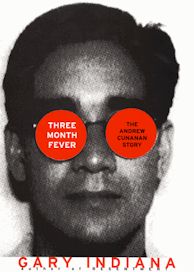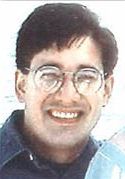 |


|
|
The Andrew Cunanan Story By Gary Indiana Three Month Fever: The Andrew Cunanan Story by Gary Indiana; Cliff Street Books; 254 pages; $25.00.  In 1997, America was shocked and riveted by the saga of Andrew Cunanan,
the young Filipino-Italian-American who became infamous by killing the openly gay
fashion designer and photographer Gianni Versace.
In 1997, America was shocked and riveted by the saga of Andrew Cunanan,
the young Filipino-Italian-American who became infamous by killing the openly gay
fashion designer and photographer Gianni Versace.
Though Versace was the fifth man Cunanan killed, he was his first celebrity; and "only celebrities have real lives". "The killer, widely ignored while he left a trail of bodies from Minnesota to New Jersey, became, abruptly, a diabolic icon in the circus of American celebrity". But Cunanan was more than a killer. He was a "homicidal homosexual"; the focus of American fears and misconceptions about gay men and gay lifestyles. "Egregiously, with little or no regard for accuracy, Cunanan's life was transformed from the somewhat poignant and depressing but fairly ordinary thing it was into a narrative overripe with tabloid evil: ugly sex, drug dealing, prostitution, et cetera", wrote Gary Indiana in Three Month Fever, his impressionistic account of Cunanan and his victims.
Though Three Month Fever: The Andrew Cunanan Story is billed as "Indiana's first full-length work of nonfiction", it has more in common with Indiana's novel Resentment (about the Menendez boys) than with Orth's journalistic account. Like Truman Capote before him, Indiana combines fact and fiction in his narrative, creating a "hybrid of narration and reflection". This comes in handy when Indiana tries to figure out what went on inside Cunanan's feverish brain, or describe dialogues or situations between Cunanan and his victims where all the participants are, of course, dead. Indiana goes so far as to "rewrite" entries from a journal that Cunanan allegedly wrote about his trip to the Philippines, to visit his estranged father. No serious reporter could get away with this, but Indiana manages to make it work.
 The Cunanan who emerges in Three Month Fever is not a "serial
killer" or a "spree killer", labels given to him by a hysterical media. On
the contrary, "the so-called spree itself hadn't been that much fun, more of
a compulsion really and furthermore one that surprised him as much as
anybody else."
The Cunanan who emerges in Three Month Fever is not a "serial
killer" or a "spree killer", labels given to him by a hysterical media. On
the contrary, "the so-called spree itself hadn't been that much fun, more of
a compulsion really and furthermore one that surprised him as much as
anybody else."
If anything, Cunanan was depressingly ordinary; a bright, handsome boy who, like many of us, tried to live beyond his means. He was into SM but no more so than many law-abiding gays; a kept boy for a while but not a "high-class male prostitute"; and though he sold prescription drugs to make ends meet, he wasn't the high-level drug dealer that Orth and her ilk imagined him to be. Ashamed of his modest origins, he invented a fantasy life for himself, as the wealthy Jew "Andrew DeSilva", a fiction that enthralled but eventually repelled his friends and loved ones. Above all, Cunanan wanted to be loved; to the extent that what others thought of him "was more important to him than life itself." Cunanan thought he found love, first with Jeffrey Trail and then with David Madson; and when these two men decided that they had enough of him, Cunanan killed them. All this does not justify murder, of course. But it makes more sense of the situation than the specter of a sadomasochistic, drug-dealing, cross-dressing, HIV+ prostitute on a rampage that the het media would have us believe. By the time Cunanan had killed Trail, Madson, real estate developer Lee Miglin (another old trick), and cemetery caretaker William Reese, he was already out of his mind (Indiana has him hearing voices). After Cunanan killed Versace, in cold blood and for no apparent reason, he was at a dead end on South Beach, and it was only a matter of time before Cunanan would have to face the consequences of his acts. Having to choose between suicide and twenty minutes on Florida's electric chair, Cunanan wisely chose to kill himself.
Indiana places Cunanan's murder of Versace within the dubious tradition, begun with the Kennedy assassination, of the "world's most important person slain by [the] world's least important person", and part of a twenty-four hour media circus that thrives upon blood and violence. "The Andrew narrative, in effect, solved the JonBenet Ramsey murder case, as that case had finally wrapped up the O.J. Simpson case, which in turn had closed the Menendez case, the Andrew mystery would ultimately be solved by the death of Princess Di, which in turn would achieve 'closure' in the form of Monica Lewinsky." The deaths of John F. Kennedy, Jr. and his wife is only the latest of a long line of media-fueled "events". We will never know what made Cunanan tick, or kill. His story is only too familiar in a world where teenagers open fire in a classroom because they were made fun of; or a man kills a dozen people (including his family) because he lost money in the stock market. Three Month Fever, though speculative at best, comes as close as any book can to understanding the enigma that was Andrew Cunanan. Gary Indiana combines the talents of a novelist, the skills of a journalist, and the empathy of a fellow queer to shed some light on this sad scenario. All that the reader can do is go along for the ride, and enjoy every disturbing minute of it. |
 © 1997-99 BEI
© 1997-99 BEI
 Gianni Versace
Gianni Versace